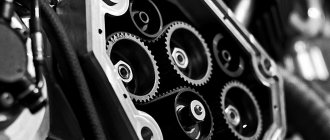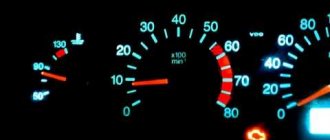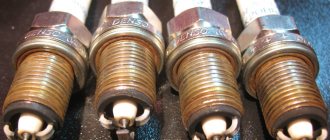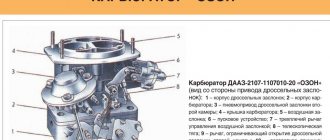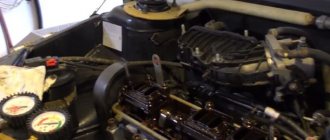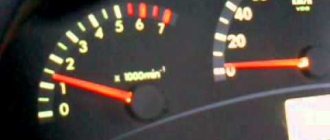In order to figure out the reason for the lack of idle speed on your own, without contacting car service specialists, you need to have at least the slightest idea of which unit to look into, which sensors to test. Fortunately, there are forums on the Internet where they will prompt you and give you practical advice, and On YouTube they will also show you what needs to be done. Our article, in general, is about this.
General concepts
One of the most common troubles that prevents you from fully driving a car is the idle speed sensor of the VAZ 2110 and modifications. Although this device is called a sensor among drivers, it will still be correctly called the idle speed controller, abbreviated as IAC, because all automobile sensors are measuring equipment, and this product serves to automatically stabilize and maintain idle speed by supplying air to the engine VAZ 2110 with the throttle valve fully closed.
IAC is an important component of the engine and plays a significant role in the stable and uninterrupted operation of any VAZ vehicle.
Idle speed control
The VAZ 2110 idle speed sensor (abbreviated DXX) is an actuator, simply a valve consisting of an electric motor, a spring, and a rod on which a shut-off needle is installed (you can see it in the photo). It is through which the volume of air is dosed. That is, when the throttle of a VAZ 2110, 2112 is completely closed, and the controller determines that the idle speed needs to be increased, the IAC generates a command to change the position of the needle. It moves, partially or completely opening the intake port, through which air bypasses the throttle and then mixes with fuel. As a result, the engine does not stall.
RPM drop in neutral gear
If the speed of a VAZ 2114 drops and the engine stalls when cold, there are not so many probable causes of the problem: a faulty fuel pump, a breakdown of the idle air control, a clogged injector or a malfunction of the coolant temperature sensor.
The main ways to solve encountered situations are as follows:
- If the reason is in the idle speed control, then the engine will constantly stall in this mode, and not just stall. To diagnose the IAC, you will need a multimeter, which measures the resistance with the engine turned off: at terminals A – B, C – D it should be approximately 54 Ohms, while between the pairs it will be equal to infinity. Any deviation from these indicators should be considered a malfunction.
- A dirty injector is a very common situation, considering how low-quality gasoline is sold at most gas stations: sometimes using a special injector cleaning agent can help. It’s worse when the injectors are clogged - if the cleaning products don’t help, you’ll have to change them or take them to a service center for cleaning.
- Failure of a fuel pump is usually preceded by characteristic signs of disturbances in its functioning: an attentive driver will hear a difference in the sound of the pump when starting the engine long before the breakdown. If the problem with the engine stalling does not occur when driving in gear, but occurs at idle, you can first check the fine filter.
- Sometimes spark plugs can fail, which directly affects the operation of the entire ignition system, but regularly replacing them for preventive purposes prevents the problem from occurring in advance. Additionally, it is recommended to check the condition of the ignition coil.
Idle speed sensor design
Composition of IAC:
- a small electric motor with a stepper type action;
- a rod with a calibrated thick needle-shaped cone and a spring;
- terminals for the block.
Device role
On injection engines that are installed on the VAZ 2110, the XX regulator serves to control the stable operation of the power unit. It is unlikely that you will be pleasantly surprised by a situation in which the idle speed starts to fluctuate, and every now and then the car will stall.
Some people do not know about another very important role of the idle speed sensor - warming up the power unit in case of low air temperature.
Advertisements
It is generally accepted that if there is an injector, there is no need to warm up the engine. The opinion is wrong. Do not overstress the engine, but first let it run for a while without increased speed. This will have a positive effect on the reliability and service life of the motor.
How does it work and how does it not work?
The sensor, or idle air control, is designed to dose air into the intake manifold while the throttle valve is closed.
Idle speed sensor disassembled.
The device is not too complicated. It consists of a stepper electric motor, a calibrated spring-loaded cone and a rod. Installed in the intake manifold after the throttle valve. It is this regulator that is responsible for the smooth and smooth operation of the engine at idle speed.
Sensor on the throttle assembly.
Simply put, the idle air control sensor is a simple valve or actuator that controls the flow of air when the throttle is closed, according to commands from the electronic engine control unit. When starting the engine in cold weather, the ECU opens the idle speed control slightly and supplies more fuel to the combustion chamber, increasing the speed to speed up the engine warm-up.
Principle of operation.
Once the engine warms up to operating temperature, the stepper motor moves the conical valve stem forward and reduces the amount of air consumed, thereby reducing the speed. This is how the sensor works.
Signs of sensor malfunction
But it does not work in cases where:
- the engine does not hold idle, the speed fluctuates;
- the engine stalls at idle and when driving in neutral with the throttle closed;
- a cold engine does not start without an open throttle, that is, until we press the gas pedal, the engine will not start;
- low and unstable idle when the engine warms up.
In this case, the Check Engine light will not light up. If it lights up, then we look for the cause in the throttle position sensor. In the case where the symptoms are present, but the lamp does not light, the cause should be sought in our sensor. Therefore, now we will check its functionality.
The pedal falls when the car starts to move
All unpleasant sensations are most often associated with a delayed reaction of the motor to pressing the pedal.
Engine stalling often occurs. The shocks appear when the throttle valve opens, then the sensor gives a signal and the ECU determines at what time to switch from idle to load mode, as well as how much to increase the fuel supply through the injectors. If the pressure is not as high as we would like, and if the injection time is increased, then there will not be enough fuel to move the car.
Also, the cause of jerking may be problems with the electromechanical part of the unit and due to clogging with waste.
Checking the idle air control
One of the reasons that the car stalls at low speeds is a malfunction of the idle air control (IAC). It should be tested to either rule out this cause or troubleshoot. There are several ways to check the serviceability of the IAC on the VAZ-2110:
- With the ignition off, connect the multimeter probes to the power supply. When they are connected, turn on the ignition and check the integrity of the winding and the power supply circuit in the following order: first, the probes are connected to pins 1 and 2. When the IAC is working properly, readings from 50 to 80 ohms appear on the multimeter sensor. When testing the 2nd and 3rd pins, as well as the 1st and 4th pins, there should be indicators indicating an infinite value.
- Visual inspection method. It is necessary to remove the regulator, disassemble it and determine the degree of coking, the degree of wear of the spring and other elements of the regulator. It is quite easy to visually determine that the regulator is simply time to change.
- It is still possible to carry out diagnostics using special testers, but purchasing such a tester will cost much more than replacing the part itself. It's up to you to decide whether it's worth purchasing such a device.
Methods for eliminating floating engine speeds
When starting to find and eliminate the reasons that cause unstable operation of the engine in idle mode, you first need to check:
- Condition of the air filter and spark plugs. If they become critically dirty, they need to be replaced.
- Integrity of insulation of high-voltage wires. If damage is found, they must be replaced.
Checking the tightness of the intake manifold (video guide)
Let's consider the remaining elements of the car, the malfunction of which can affect the smooth operation of the VAZ 2114 engine in idle mode.
Solenoid valve diagnostics
Cars with engines equipped with a carburetor are equipped with idle speed solenoid valves. Devices are checked as follows:
- Disconnect the power cord.
- Start the engine to warm up.
- Connect the wire. If a clear click is not heard, the part must be replaced.
Is the EGR system on the injector working?
"Floating" speed can be caused by jamming of the exhaust gas recirculation (EGR) valve, which is installed in the exhaust manifold. It is necessary to periodically remove dirt from the valve seat and its seat using a carburetor cleaning aerosol, avoiding liquid getting on the sensor diaphragm.
Keep the valve seat clean
Adjusting the idle speed on a carburetor engine (with video)
Note that the main reason for the appearance of floating idle speed in engines of this type is the incorrect operation of the carburetor. The device is adjusted by rotating the fuel quality and quantity screws.
Is the idle air control valve working correctly?
The IAC is checked by measuring the electrical resistance at the contacts - to diagnose the device you will need a tester (multimeter) set to the “ohmmeter” operating mode. To check the details:
- Let's turn off the ignition.
- Disconnect the connection block.
- Let's measure the resistance on contacts A - B and C - D of the device. The optimal readings of the device vary from 40 to 80 ohms.
- Let's repeat the measurements with contacts B - C and A - D. In this case, the multimeter should show “infinity” or an open circuit.
Any violation of the normal resistance values means a malfunction of the regulator. IAC failure is a common cause of floating engine speed at idle, and if a malfunction is detected, the device must be replaced. Before you begin dismantling the part, you must disconnect the negative wire from the battery. After installation, the new IAC is calibrated - the removed terminal is returned to its place, the ignition is turned on and after 5-10 seconds (there is no need to start the engine).
IAC failure is a common cause of floating engine speeds.
Cleanliness of the damper assembly
The throttle valve assembly is diagnosed by visual inspection for contamination. Clean the part with cotton swabs and a toothbrush moistened with a cleaning solution. For ease of work, the device is dismantled. After cleaning, it is recommended to blow out all channels and pipes of the unit with compressed air using a tire inflator.
To clean the part, it must be dismantled
Video: How to clean the throttle body
Is it possible to diagnose DPKV and DSA?
A breakdown of the DPKV and DSA (Hall sensor) is indicated by the Check Engine indicator that lights up on the car’s dashboard. Testing these devices is only possible using special instruments (oscilloscopes). You can first check the integrity of the wiring; if it is broken, the damage should be repaired.
- The DPKV sensor is installed on a bracket located in close proximity to the generator drive pulley.
- The DSA is located on the speedometer drive mechanism of the gearbox.
For a more detailed introduction to methods for detecting faults associated with engine malfunction in idle mode, it is recommended to watch the following video.
Video: Computer diagnostics of VAZ 2114 idle problems
So, the main steps to rid the car of floating engine speed at idle are considered. Remember: if performing these operations yourself does not lead to a positive result, you will have to contact a service station with the necessary diagnostic equipment and qualified repairmen.
Testing the mass air flow sensor (MAF)
Let us remind you what we are talking about - VAZ-2110 8-valve injector: the speed drops and stalls. A reasonable question arises: what to do? If the reason is not the IAC, then it is worth testing the mass air flow sensor. Here are some recommendations on how to do this:
- Disconnect the sensor connector from the on-board system. The controller that controls the engine will operate in emergency mode, but for short testing this is not fatal. If your car runs much faster, then the problem is most likely in the mass air flow sensor. It's time to clean it.
- Replace the sensor with a working one, and then see how the engine works. There are improvements, which means you need to either clean or replace your own mass air flow sensor.
- It also makes sense to inspect the air intake; to do this, you need to remove the mounting clamp and carefully inspect the inside of the air intake, there should be no condensation or oil there. If any are found, then it will have to be cleaned with special means.
- You can also test the mass air flow sensor using a multimeter. To do this, you need to switch the multimeter to voltmeter mode and set it to 2. The sensor has 2 wires - yellow and green. Yellow transmits a signal to the controller, and green transmits a signal to ground. When the ignition is turned on, we take measurements between these two wires. The engine should not be running. If the readings are in the range of 1.01-1.02, then the sensor is in perfect order. Readings in the range of 1.02-1.03 – it’s time to clean the sensor. And if the indicators go off scale to 1.04, then it’s time to get a new sensor.
We recommend: Arranging the exterior of your car
Checking the serviceability of the throttle position sensor (TPS)
Our problem may be caused by a faulty DPSD. But it is this sensor that is tested last, when everything has been tried and tested. But in vain, it is easy to test, you can save a lot of time and money if you check this sensor. How to do it:
- This sensor is located on the throttle pipe, it is connected to the throttle axis. The sensor is secured with two screws. When removing the sensor, you should pay attention to the condition of the throttle valve, whether it is coked. If yes, then there will be the same symptoms as with problems with the sensor. However, the sensor can be checked without removing it.
- To do this, you need to measure the voltage at the DPSD terminals when you turn on the ignition, and it should not exceed 0.7 V.
- Next, open the throttle using the plastic sector, and then measure the voltage again. It must be at least 4 V.
- Next, check the voltage at the DPZD terminals when the damper moves. It should not change; abrupt changes indicate a sensor malfunction.
Having found out that the sensor is faulty, it should be replaced. On the VAZ-2110, 2 types of DPZD are installed - film-resistive and non-contact. The first is designed for 55 thousand mileage, the second is unlimited, but much more expensive than the first.
Replacement procedure
Replacement is carried out in the following order:
- We de-energize the on-board system by removing the negative terminal, which is located on the battery;
- Disconnect the block from the sensor. For a VAZ injector this happens by pressing a plastic latch;
- We unscrew two screws, and it is recommended to first unscrew the left fastener, then the right one;
- Now the regulator has been removed and there is no problem in replacing it with a new one;
- Before installation, it is advisable to spread oil on the sealing ring. See if there are even the slightest cracks on the ring, in which case it needs to be replaced;
- There is also no difficulty in the calibration procedure; the electronic relay will do everything. You just need to turn on the ignition for a few minutes and then turn it off. After this, the speed usually no longer fluctuates, and the car works without failures.
The speed drops when the carburetor warms up - we’ll deal with the problem
A drop in engine speed is quite an unpleasant incident for your car. We are talking not only about inconvenience and questions about the serviceability of the machine, but also about the operation of important mechanisms. The problem is that a sharp drop in idle speed, when the car rolls into neutral, can shut down the engine, and this already becomes dangerous for further movement. The driver may not notice such an incident, engage second gear and release the clutch, which will cause sudden engine braking. The car can start “from the pusher” in this way, or it can simply stop, which will create an emergency situation. When the car warms up, a drop in speed also has an unpleasant effect on the driver's confidence. You have to constantly apply the gas with your foot or use other methods to keep the engine in working condition. It is worth understanding the causes of the problem.
So, why do the revs drop when warming up on cars with a carburetor? You can find many common reasons that unite owners of both a certain car model and a specific type of carburetor. It must be said that today cars with this type of fuel injection are no longer produced. This is not the best solution, since the carburetor is very sensitive to the quality and purity of the fuel, requires maintenance quite often and does not serve very well in different climatic conditions. This type of gasoline injection requires stability, but in our operating conditions it is simply impossible to provide such luxury to a car. Therefore, various problems arise that can lead to significant discomfort and even danger in driving a car. Today we will look at the main reasons for a sharp or wave-like drop in speed when warming up on cars with carburetor fuel injection.
Checking the sensor yourself
The sensor is located in the throttle body and to remove it for inspection, you just need to unscrew two screws.
To dismantle the IAC, you need to disconnect the block and unscrew two screws.
Before dismantling, you need to thoroughly clean the place of its attachment from dust and dirt and remove the negative terminal from the battery. But first, a check.
Sensor connection diagram.
We look at the connection diagram and check the sensor using a conventional multimeter in the following sequence:
- Check for power supply to the sensor. To do this, measure the voltage at the two outer contacts of the block, A and D. Turn on the ignition, place the black probe of the multimeter on the engine ground, and the positive probe on the contacts one by one. The voltage should be within 12 Volts. If it is less or absent altogether, we look for an open circuit or blame the electronic control unit for everything. But first, we check the voltage at the terminals from ECU 4 and 54. Here, naturally, there should also be 12 V.
The voltage is normal.- We switch the multimeter to ohmmeter mode and measure the resistance between contacts A-B and C-D on the sensor itself. As can be seen from the diagram, we are checking the resistance of the winding of the stepper motor of the regulator. Between the indicated contacts, the nominal resistance is from 40 to 80 Ohms, according to the factory rating - 53 Ohms.
- We check the electric motor for short circuit of the windings. To do this, measure the resistance at terminals A-D and B-C. The resistance should tend to infinity, that is, there should be no contact between the two windings. If there is resistance, no matter what the value, we conclude that the windings are short-circuited. This cannot be cured; we replace the sensor with a new one.
It cannot be said that this testing method 100% guarantees the functionality of the sensor; we only checked its electrical part. The mobility of the cone valve and the magnitude of its stroke are of great importance. And this can only be checked either at a special stand or with a special tester.
Checking the operation of the mechanical part of the sensor
To check, remove the sensor from the throttle assembly.
However, if the electrical part is in order, you can check the mechanical part of the regulator by eye:
- Unscrew the sensor and remove it from the throttle body.
- We connect the contact block to the sensor.
- Turn on the ignition. When turned on, the valve should move forward. If this does not happen, the rod is coked or the stepper motor is not working properly.
- We measure the distance between the sensor body and the conical valve - nominal 24 mm.
We measure the distance with a caliper.
If we removed the sensor from the car and the electrical test passed, but we still did not achieve mobility of the cone valve, we try to clean the regulator using a soft swab, a cotton swab and WD-40 penetrating lubricant or an aerosol carburetor cleaner. Good luck to everyone and stable idle speed in any weather!
Sensor with carbon deposits.
Soak the valve in cleaner.
Cleaned sensor.
Does not reach warm-up speed — Lada 2110, 1.5 l., 2002 on DRIVE2
, which I wrote about earlier: www.drive2.ru/l/493954225462575781/ www.drive2.ru/l/493956149607924070/ www.drive2.ru/l/494483365433442493/ appeared again
, again
you need to hold the gas pedal
for a while
until it warms up or reaches the required speed on its own
.
I decided to catch this moment with the computer connected and the next problem turned out to be IAC, it just has a stepper motor. I look at the stepper motor parameter, the reading is 112 steps, I hold the pedal (the engine is cold), then the revolutions begin to increase on their own, and the readings become 50 steps and are added just up to the same 112 steps
.
Of course, the IAC was bad, the ECU took incorrect readings from it - it was written incorrectly, that is, most likely it simply jammed and did not move as many steps as the impulses came to it, and it was a new IAC, how to say new, when it first appeared this problem, I immediately bought a new IAC and installed it, but no miracle happened. In my deposits of “treasures” I had one removed for more than 5 years from my brother’s 10, IAC, visually inspected it, washed it, lubricated the rod with silicone grease, after which it lay in a vertical position with the rod upside down for about a week (there was no time), then installed
this
IAC
and lo and behold, it’s a completely different matter
when the car starts up, the tachometer needle jumps a little
, as it should be, as if it had become younger
A bad tooth, it’s better not to buy such an IAC
Based on the comments, you can also try express repairs, lubricate the IAC rod with some kind of penetrating lubricant, the same VD-40
Issue price: 20 ₽
Diagnosis of IAC mechanics
The mechanics may be broken. The main thing that is checked during diagnosis is the mobility (length) of the bolt cone. The 100% condition of the device can only be determined with a special stand or a special tester, but an eye check can also reveal the cause of the problem.
Checking the sensor for mechanical service involves removing it. Procedure:
- We put the vehicle in handbrake.
- Remove the “–” terminal from the battery.
- Disconnect the block from the valve.
- We clean, wipe the place where the product was located, the fastenings.
- Unscrew the fasteners and remove the part.
Instructions on how to check the idle speed sensor on a VAZ 2110 (injector, 8 or 16 valves) after removing it:
- We connect the sensor to the block.
- We connect the battery.
- We activate the ignition - the cone shutter should move forward. If this is not observed, there may be a malfunction of the rod (possibly coking) or the motor. The norm for the protrusion of the needle (cone) from the body of the product is 23 mm. When operational, if power is supplied, the rod changes position.
We recommend: Which countries are best to travel to by car?
Cleaning DXX
You cannot ignore such a basic procedure as cleaning - this can give results, since sometimes parts of the product, contacts, become coked, covered with dirt and oil.
What you need for cleaning:
- cleaner (lubricant) WD-40 or similar cleaning products for equipment;
- cotton wool, clean rags, tampons.
Cleaning:
- The sensor is completely dismantled, with the block disconnected.
- The swab is moistened with the cleaning mixture. You can also spray the product with an aerosol.
- Carefully wipe the contacts, needle, and installation sites, especially if oil is found there.
Before installation, the regulator is dried, the protrusion of the needle from the body is measured (the norm is 23 mm).
If the sensor has a malfunction of the electrical part - the winding, the electric motor - then repair is impractical or impossible. They buy a new product, especially since it is not too expensive (on average 500–700 rubles, but can be found for 250–300 rubles).
If the problem is in the block with wires (you can buy a new one), loose contacts or contamination, then repair is advisable. Repair also makes sense if there are serviceable parts of an identical product - you can disassemble it and try to replace these parts. But we must take into account that usually such a repaired device breaks down more often and the inconvenience caused by this will be very unpleasant, so it is usually more profitable to immediately buy a new product.
Step-by-step replacement procedure
The replacement procedure is carried out in almost the same way as cleaning the device, but there are certain nuances:
- The battery is disconnected to prevent a short in the wiring.
- The plug with the electrical circuit is disconnected from the control device. If the car is equipped with an injection power unit, then to disconnect the connector you need to press on the plastic fastener.
- The bolts are unscrewed. As when cleaning, first unscrew the left fastener, and then the right one. The failed regulatory device is being dismantled.
- The surface on which the sealing element is mounted is also cleaned. The latter is checked for defects - abrasions, cracks, etc. If they are present, the sealing gum is replaced with a new one. Before installation, the seal is treated with engine fluid, after which it is mounted on the throttle seat.
- The controller is installed, a connector with wires for its power supply is connected. A wire is connected to the battery.
- After installation, a calibration procedure is performed. The microprocessor module must perform this independently; an electronic relay is used for this. To calibrate the new sensor, the ignition is turned on for a few minutes and then turned off. If the actions performed helped and the speed no longer floats, but remains at the same level, then the replacement procedure can be considered complete.
What do you need to know when replacing the IAC?
To change and install a controller that allows you to regulate idle speed, you need to pay attention to the position of the rod. It must not be allowed to be pushed forward too much. This can happen if the device is connected to the block and the ignition is activated before installation. It is not allowed to push the rod in by hand.
If the valve is installed with the needle extended and the retaining screws are tightened, damage to the unit may occur due to shearing of the worm gear. It is impossible to repair such a sensor. Depending on the vehicle model, after installing a new regulator, it may need to be calibrated. In some cars, this procedure is carried out using special equipment or a stand.
On VAZ cars, calibration is performed as follows:
- A terminal is connected to the negative output of the battery.
- The key is turned in the lock to turn on the ignition for ten seconds. There is no need to start the power unit.
- The ignition is turned off.
Learning to distinguish a fake from an original
Today, many people complain about the abundance of counterfeit products on the auto parts market.
If we talk specifically about the XX regulator for the VAZ 2110, then there are several key signs by which a fake can be distinguished from the original. Be guided by these data so as not to accidentally install a device of dubious quality and origin on your car.
Fake and original
- On fakes, the black body made of metal is 1 millimeter shorter than the real part.
- In the case of the fake, the three white rivets on the case have no heads. They must be present in the original. And the diameter of the caps is 3 millimeters.
- On fakes, the spring is made in white and has more frequent winding. In the original, the coiling is less frequent, and the spring itself is black.
- Pay attention to the rubber ring of the regulator. On fakes it is black and thin, but in the case of a real part, a reddish tint is noticeable. Plus the thickness is greater.
- Take a closer look at the tip. In fakes it is darker compared to the original spare part.
- There are no markings on the counterfeit packaging; the boxes are noticeably different in appearance.
- The original yellow sticker located on the case must have an outer frame. Manufacturers of counterfeits apparently forgot about it.
As you can see, recognizing a fake is not difficult. You just need to be more attentive to details.
The difference is in the boxes
Replacing and calibrating a new IAC
Replacing the idle speed valve sensor on a VAZ 2110: the part is inserted, the screws are tightened, the leads are connected according to the diagram (available in the instructions for the IAC or on the network). The idle speed control of the VAZ 2112 has 16 valves and on other vehicles with a power system of a similar design, it is located in the same standard way.
It is highly advisable to calibrate the IAC after replacement:
- Ignition for 7–10 seconds, without starting during this time.
- Start the internal combustion engine. Jumps and increased speed may be observed.
- Turn off the engine - the rod will move to another extreme position.
- Repeat the described steps 2-3 times.
- Run the engine for approximately 5–7 minutes.
It must be remembered that the calibration is reset after disconnecting the IAC or after removing the negative terminal from the battery. This procedure will help the speed “stand up” more correctly for better functioning of the system.
Problems on the go
Now it’s time to deal with the problems that arise on the road. It happens that the engine stalls while driving. In this case, it is best to call a tow truck or enlist the help of other drivers to deliver the car to a garage or the nearest service station.
If you have some skills in handling cars, then you can check several suspected problem components and parts yourself:
- Spark plugs - they are almost always checked. If they are not working, replace them with new ones.
- A dirty fuel filter blocks the flow of fluid, resulting in a lack of fuel causing the engine to stop working. Check the filter, clean or replace it.
- The air filter may also become clogged. If this is the problem, you will notice not only unstable operation of the engine unit, but also a significant decrease in engine power, which occurs due to the fact that there is not enough air to create a high-quality combustible mixture.
- Serious problems can arise if the fuel pump is faulty. Insufficient pressure appears in the system, and the car begins to stall due to poor fuel flow into the combustion chamber. Check, repair or replace the part.
- The battery is another element that is very rarely checked after the engine is stopped. The operation of electronic devices rests on it; as soon as it is discharged, the machine will stop. The contacts of the device may also be oxidized, but they can be easily cleaned.
- After the battery, it is worth checking the generator. This could be the reason why the battery is discharged. The battery will have to be charged, and the generator will have to be repaired or replaced with a new one.
We recommend: How much oil to fill in a VAZ 2110 engine - the answer is here
Are there any other reasons for the sharp drop in revolutions?
There can be many reasons for such trouble. If you are repairing a car yourself, you should take a slightly broader look at the problem and try to find the causes in other components. But you should move on to other features of the car only if you are convinced of the high quality of the carburetor, normal fuel and other features mentioned above. Here are some more ideas to check out:
- fuel filters - very often filter elements become clogged, and owners forget to change them on time, and this leads to serious problems with the vehicle;
- thermostat - perhaps after a slight warm-up of the small circle, your thermostat opens and releases sharply icy liquid into the engine, which leads to a drop in speed;
- electronics - it is worth checking the ignition, the normal installation of the timing belt, the absence of problems with sensors and various electronic equipment on board your car;
- turning on electricity consumers - perhaps some powerful device is automatically turned on in your car, which puts a load on the unit, the speed inevitably drops;
- valve system - there will be no sharp drops and drops in this case, but floating and unstable speeds are quite possible, and under load they will turn into drops.
There can be many reasons for engine instability. Sometimes the problem is that the generator at a certain point stops producing normal voltage, which affects the operation of the engine's electrical systems. The engine may also be stressed due to poor oil or internal failures in the cylinder block or valve system. So in this case, you can dig for quite a long time, but it is better to visit a service station and find the cause of the problem.
We suggest watching a video with a solution to one of the possible causes of this problem:
Why does it start and stall?
If you turn on the logic, there may be several main reasons why the engine stalled after starting:
- insufficient amount of fuel;
- exhaust system malfunctions;
- failures in the formation of the air-fuel mixture and its supply to the injectors.
It can be assumed that the cause is faulty spark plugs or a clogged air filter. But spark plugs do not all fail at once. If one spark plug does not work, the engine starts to stall, but this will not cause it to stall. To clog the filter to such an extent that it is unable to pass air through itself requires a lot of effort. When there is no air supply, the engine will not start at all, and even if it does start, the thrust will drop significantly. Traveling would be difficult, if not impossible.
Exhaust system malfunctions
Everything is simple here: if you close the pipe tightly, the engine will stall after some time. Even if you start it again, it will run for a few seconds and then die again. This happens because the exhaust gases have nowhere to go: they cannot get out, and fall through the exhaust manifold back into the combustion chambers. There, the gases mix with the air-fuel mixture, ignition becomes impossible, and the engine stalls.
Exhaust gases are not removed for several reasons:
- catalyst malfunction (can also be heavily contaminated);
- water in the muffler.
The situation with a clogged catalyst is rare. To do this, the water in it needs to freeze, but this is unlikely.
But water in the muffler happens quite often. It freezes in winter and exhaust gases cannot escape. There are few reasons why water gets in. Basically, this is a broken cylinder head, which causes antifreeze to enter the exhaust system and, mixing with condensate, freezes. Although, if the cylinder head gasket is punctured, the problem of ice in the muffler will seem like a trifle, since more serious repairs await.
Incorrect fuel/air mixture
Such situations occur frequently. In this case, the engine either does not start at all, or runs erratically. There are few reasons, these are:
- incorrect operation of the throttle assembly;
- air intake in addition to the air duct in front of the air filter (suction).
The throttle valve is directly involved in the formation of the fuel mixture, and disruption of its functioning leads to malfunctions of the power plant. The air leak makes the mixture too lean, and the engine cannot work on it, which is why it stalls. To eliminate these problems, you need to clean the throttle assembly (or replace it if it is faulty) and look for the location of the air leak.
Insufficient fuel supply
The symptom is simple: after starting, the engine runs for 5–10 seconds and stalls. In most cases, the cause is the fuel pump located in the fuel tank. To be precise, the problem is a clogged fine filter or mesh. This detail, insignificant at first glance, does not allow dirt particles to enter the fuel line, which, like water in the gas tank, is abundant (especially on cars with a mileage of 50,000 or more).
In summer, the water and other substances in the tank are liquid and can pass into the main line, but in winter they often turn into ice on the mesh filter. This causes the fuel pump to be unable to pump enough fuel to run the engine. Therefore, it turns out that the pump manages to pump a little fuel, and this is just enough to start the engine, but no more. To eliminate this problem, it is enough to replace or clean the fuel pump mesh.
If not the valve, then what?
Dirt, low-quality fuel, malfunction of the ignition system - all this separately and in the compartment can affect the idle speed disappearing or becoming unstable. If you have already decided to carry out a full diagnosis, then start with the filters - air and fuel.
If they are heavily clogged, then gasoline or air (these are the main components of the air-fuel mixture) will not enter the carburetor normally. To be more precise, they will hit, but only after overcoming great resistance. And don't forget about the thimble-shaped filter that is installed at the inlet of the carburetor.
The solution is to replace all the filters and not have to worry anymore. But if this does not help, then you have many more faulty nodes. This means it’s time to look at the spark plugs (at the same time, remember how long ago you changed them). Unfortunately, a rare spark plug will last more than 30 thousand km.
And this is about a year and a half of operating the car in average mode. Unscrew the spark plugs, look at the carbon deposits, whether there is any and what color it is. With a long service life, the central electrode of the spark plug wears out and the gap increases as a result. Replace the spark plugs and check if the idle speed is stable.
Does it still stall at idle and not hold the revs? Then the ignition system remains. If you have a contact one, then check the gap in the breaker and set the optimal advance angle. If contactless, then diagnose the switch and Hall sensor.
These two elements fail more often than others. However, there is nothing more to break. Also inspect the condition of the high-voltage wires and, if necessary, remove moisture or dirt from them. The distributor cover should be without damage, and the resistance of the resistor in the slider should be about 5.5 kOhm.
Let's sum it up
As you can see, even taking into account the relative simplicity of the part itself, the IAC performs a number of important functions. Of course, if a malfunction occurs in the internal combustion engine, it is necessary to check this element. At the same time, for diagnostics and maintenance of the VAZ 2110 idle speed sensor, no specialized equipment is required. Also, replacing the XX regulator can be done with your own hands in a regular garage.
Finally, we note that sensors of this type are quite reliable and rarely fail. However, problems still arise on cars with high mileage. In any case, if the idle speed is disrupted, it is important to make sure whether the breakdown is really related to the IAC. The above information will allow the driver to quickly check the sensor (electronic and mechanical part of the idle air valve).
Sources
- https://KraiAvto.ru/vaz-2110/datchik-holostogo-hoda-vaz-2110-neispravnosti-proverka-i-zamena-rhh-vaz-2110/
- https://ladafakt.ru/net-holostogo-hoda-na-vaz-2110-inzhektor.html
- https://osensorax.ru/rashod-uroven/datchik-holostogo-hoda-vaz-2110
- https://ladaautos.ru/vaz-2110/chto-delat-esli-padayut-oboroty-i-gloxnet-vaz-2110-8-klapanov-inzhektor.html
- https://carfrance.ru/priznaki-neispravnosti-datchika-xolostogo-xoda-na-vaz-2110/
- https://prometey96.ru/ustrojstvo/vaz-2110-glohnet-na-hodu.html
Let's list them.
- The most basic is a malfunction or failure of the mass air flow sensor.
- No less common is the breakdown of the idle air control valve.
- A crankshaft position sensor providing incorrect information to the control unit can also be the root cause of a high or floating idle.
- The throttle position sensor may also be to blame.
- It happens that for some reason the gas pedal does not return all the way back. Moreover, this happens both because of a banal malfunction of the cable, and because of something completely ridiculous - for example, after washing the car, they covered the driver’s mat in such a way that the tip of the mat began to touch the pedal.
- The air filter is very clogged. Because of this, the combustion mixture is too rich in gasoline, again resulting in high idle speeds.
- The cable came off the throttle valve.
- Engine temperature sensor faulty. It gives the car’s “brains” incorrect values, which increase the crankshaft speed, thinking that the engine is cold.
As you can see, we have before us a whole forest of very different reasons why high revs appear! Next, we will take a closer look at the most typical, plus the most common problems associated with the problem described. At the same time, we’ll figure out how to eliminate them with our own hands.




